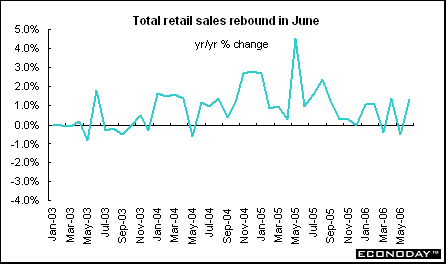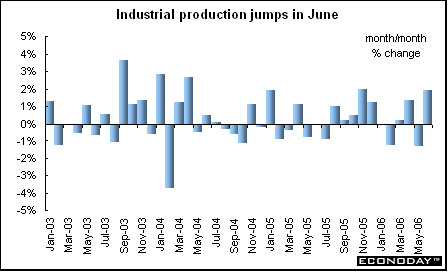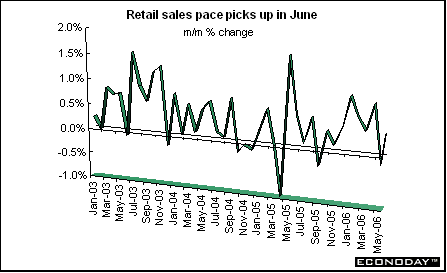The three central banks meeting this past week all increased their policy interest rates, each by 25 basis points. The European Central Bank rate increase was expected while the Reserve Bank of Australia increase was pretty much expected. But the Bank of England rate increase was not expected, at least by most. Stocks dropped in each of the local markets in response to the moves. The ECB policy rate is now 3 percent, the Bank of England's 4.75 percent, and the Reserve Bank of Australia's 6 percent.

Equities were volatile in the week as investors contemplated earnings reports and waited philosophically for the individual central banks to meet. Markets were thin as they typically are in August, which is a high holiday season in Europe as elsewhere. Investors were nervous over the geopolitical concerns in the Middle East as Iran rebuffed the UN on its nuclear program and the fighting continued in Israel and Lebanon. As Friday approached, investors nervously awaited the U.S. employment situation report. While employment and unemployment were weaker than expected, wage increases were stronger than expected, implying that there could be cost push inflation adding to price increase concerns. On the week, four indexes were down while the remaining nine were up.
Global Stock Market Recap

Europe and the UK
Stocks in the UK and Europe were volatile. On the week, the CAC and DAX were up while the FTSE, shocked by the Bank of England interest rate move, was unable to make up its losses. But earnings results also supplied investors with an excuse to sell - and then buy. In the fore were mining stocks, which now make up a large part of the FTSE. For this sector, crude prices and geopolitical events influenced investors. And banking stocks, which were hit on Thursday amid fears that higher interest rates could trigger a jump in bad debt, recovered on Friday. Insurers also boosted the stock averages on Friday.

Both Bank of England and ECB increase rates
While virtually all analysts expected the European Central Bank to increase its policy rate on Thursday, most did not expect the Bank of England to do anything other than maintain its policy rate at 4.5 percent for another month.

Strong economic data since the last meeting of the Bank of England's monetary policy committee in addition to the impact of higher energy prices and capacity restraints on prices were cited as the main reasons for the 25-basis-point rate increase to 4.75 percent. Equities swooned but the pound sterling jumped against the U.S. dollar. The Bank of England's inflation measure has been at or exceeding its 2 percent target for nine of the past 12 months. The CPI's reading for June was 2.5 percent when compared with the same month a year ago.
There was no surprise involved with the European Central Bank increase, however. It had been well telegraphed in a number of ways since the July meeting. In the July press conference, President Jean Claude Trichet used the word 'vigilant' which analysts now perceive as a code word for rate increase. The governing council also decided to meet in Frankfurt rather than have their usual August conference call. And a press conference was added to the schedule. The ECB has been distressed by price increases above its 2 percent ceiling. The last time the harmonized index of consumer prices was under that level was in January 2005. The ECB also monitors M3 money supply growth. Here too, money supply growth is running hot, almost double the 4.5 percent ECB target.
Asia/Pacific
Investors will have to wait until Monday to react to the U.S. jobs report. But by that time, they will be on hold awaiting the FOMC meeting announcement. Since these markets will be closed when the announcement is made, they will have to wait until their Wednesday trading session. The Hang Seng was down on the week on interest rate concerns while the all ordinaries dropped after Wednesday morning's announcement, local time (Tuesday night in the eastern U.S.), of an interest rate increase by the Reserve Bank of Australia to 6 percent. Again inflation concerns dominated the decision.

RBA policy rate now 6 percent
The Reserve Bank of Australia increased their policy interest rate by 25 basis points to 6 percent on Wednesday. The RBA cited rapidly growing retail sales and an unemployment rate which is currently at a 30-year low. As expected, stock prices were down while the Australian dollar was up in value. Second quarter consumer price index jumped 4 percent on the year, far exceeding the RBA's 2 to 3 percent target range. Inflation is being driven by gasoline and fruit prices. Fruit prices surged 52 percent after a cyclone wiped out most of the country's banana crop.

Glenn Stevens, currently a deputy governor of the RBA, has been selected as Governor for a term of seven years beginning on September 18, 2006. He will replace Ian Macfarlane who will be retiring. Macfarlane has served 10 years as governor. When nominated for a second term, he requested that it be for three years rather than seven. Stevens has been a deputy governor for five years. No one was named to replace Stevens as deputy as yet. Governor Macfarlane will chair his last meeting on September 5th before retiring on September 15th.
Later in the week, the RBA raised its inflation and economic growth forecasts in its quarterly statement on monetary policy. This has led analysts to believe that there will be more interest rate increases this year. In its report, the Bank said it expected core inflation to be above 3 percent over the next two years. Three percent is the upper limit of the Bank's 2 to 3 percent inflation target range.
Currencies
The yen and euro traded within narrow ranges last week until Friday, when the weak employment report sank the U.S. dollar and pushed both currencies higher. The euro was also lifted higher by the ECB interest rate increase to 3 percent on Thursday. The employment report had been preceded by a muted GDP report the previous week. Second quarter annualized growth was 2.5 percent, less than half that of the first quarter's 5.6 percent rate. The combination was interpreted to mean that the Federal Reserve Open Market Committee, when it meets Tuesday, would have an excuse to pause in its string of rate increases.

The pound sterling soared against the U.S. dollar thanks to the Bank of England's surprise rate increase on Thursday and the weak U.S. employment report on Friday. The last time it was over $1.90 was briefly in April 2005.

Indicator scoreboard
EMU - July flash harmonized index of consumer prices was up 2.5 percent when compared with last year. As with all flash reports, no detail was available. The HICP has been above the ECB's 2 percent inflation target since February 2005.

June unemployment rate edged down to 7.8 percent from 7.9 percent in the previous month. Unemployment was down in Germany and France while in Spain the rate was unchanged. While using the same raw data as the source for its calculations, Eurostat's methodology and definition of unemployment differs from that of the national governments producing differing rates.

July manufacturing purchasing managers' index edged down to 57.4 from 57.7 in June. The PMIs for Germany, Italy and Spain were down while France's was up. Both input and output prices were up for the EMU and the four major countries. Both production and new orders eased.

July services purchasing managers' index dropped to 57.9 from 60.7 in June. There was a marked slowdown in Germany after the World Cup in June and the ripple effects were felt throughout the EMU. All the major countries were down in July including the UK and the U.S.

June producer price index was up 0.2 percent and 5.8 percent when compared with last year. PPI excluding energy was also up 0.2 percent and 3 percent on the year. Both intermediate prices and nondurable consumer goods prices were up 0.3 percent.

June seasonally adjusted retail sales were up 0.5 percent and 1.5 percent when compared with last year thanks to a boost from the World Cup. Food sales were up 1.1 percent after sinking 0.8 percent in May. Non-food sales were down 0.1 percent, reversing May's gain.

EU - July economic sentiment index climbed to 107.7 from 107.1 in June. Industry sentiment edged up to 4 from 3 in the previous month while consumer sentiment remained unchanged at minus 9. Services sentiment was unchanged while both retail and construction sentiment were down on the month.

Germany - July seasonally adjusted unemployment dropped by 84,000. In the West, unemployment dropped by 58,000 while in the East it was down by 26,000. The pan-German unemployment rate declined to 10.6 percent from 10.8 percent in June while the rate in the West declined to 9 percent from 9.2 percent. The unemployment rate in the East finally dropped below 17 percent to 16.9 percent from 17.2 percent in June.

June preliminary retail sales excluding autos and gasoline stations were up 1.9 percent but were down 0.4 percent when compared with last year. These data are based on six German states that account for about 74 percent of total sales. The data were also influenced by the World Cup which was held in June. Total retail sales (including autos and gasoline) were up 1.4 percent both on the month and on the year.

June real seasonally adjusted manufacturers' orders were down 0.5 percent and up 6.5 percent when compared with last year. Domestic orders were down 1.2 percent, reversing May's gain. Orders for investment and consumer goods were down. Foreign orders were up 0.2 percent after sinking 3.9 percent in the prior month. Capital goods orders were down 1.2 percent with domestic orders dropping 3.4 percent while foreign orders increased by 0.3 percent. Consumer goods orders sank 4.2 percent thanks to declines in both domestic and foreign orders.

Asia
Japan - June industrial output jumped by 1.9 percent and 4.9 percent when compared with last year. Auto and transportation equipment output was up 5.9 percent. Shipments climbed 0.7 percent on the month, while inventories grew 0.5 percent.

Australia - June retail sales were up 1 percent and 5.6 percent when compared with last year. Sales were boosted in anticipation of a July 1st tax cut. Sales of cosmetics and jewelry surged 2.8 percent while clothing sales rose 1.4 percent and spending at department stores climbed 1.2 percent.

Americas
Canada - May monthly gross domestic product was unchanged on the month and up 2.6 percent when compared with last year. Manufacturing edged up 0.1 percent but mining, oil & gas extraction and construction were down. Ten of 21 major groups accounting for 36 percent of manufacturing were up on the month. Services were up 0.2 percent but retailing was down on the month.

July employment was down by 5,500 jobs after declining by 4,600 in June. These declines are miniscule when compared to the hefty employment increases in the first five months of this year. The unemployment rate was 6.4 percent, up from 6.1 percent in the two prior months. A jump in labor force participants by 64,200 contributed to the higher unemployment rate. Full time employment was up by 21,600 while part time employment was down by 27,000. Gains in service producing industries were not enough to offset losses in the goods producing parts of the economy.

Bottom line
This week saw three central banks respond to ever rising price pressures by increasing their policy interest rates. Interest rate increases are good and bad news. For equity investors, the bad news is that higher rates could cut into profits. However, a positive sign here is that economies are growing and could provide higher earnings that would offset the additional costs. But for those involved in the currency market, higher interest rates are usually good news especially for those who profit on interest rate spreads between countries. For example the pound sterling was up on the U.S. jobs news. For the equity market, the U.S. employment situation report was initially considered good news on the assumption that a weak report equaled a halt in Federal Reserve interest rate increases. But as the day progressed, slower growth prospects outweighed prospects for steady interest rates and U.S. equities ended down on Friday.
The jury is out on whether the Fed will increase the Fed funds target rate yet again on Tuesday, although analyst opinion looks for a pause especially after the weak employment report. No action is expected from the Bank of Japan when they meet later in the week - they are moving very cautiously in assuming a more normal policy stance. Second quarter flash GDP estimates will be available Friday from France and Italy and a preliminary GDP estimate from Japan will also be released on Friday.

